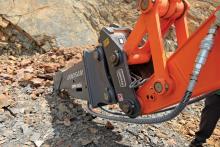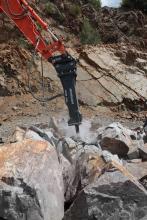
While rock mining with heavy-duty hydraulic breakers is not feasible in every quarry, it is seen as an alternative to explosives. Once, such breakers were looked on as auxiliary equipment to be used after drill and blast to reduce rocks further where necessary for crushing, but manufacturers are claiming that large breakers can offer advantages on production, costs and the quality of the material. Patrick Smith reports
“For operations with an output of up to 600,000tonnes/year, feasibility studies should be carried out to show whether the use of heavy-duty hydraulic breakers represent an economic alternative to drilling and blasting,” says
“There are no two identical quarries anywhere in the world, so whether the use of hydraulic breakers represents a viable alternative has to be analysed on a case by case basis.”
Italian manufacturer
“Add to this, when mining very precious material the breaker minimises the quantity of waste inevitably produced by explosives. The breaker can also create the profiles necessary for environmental restoration, today a critical requirement for any mining activity, while it also performs the primary crushing.
“The breaker substantially reduces the problems caused by explosives disturbing communities in areas surrounding the quarry,” says Indeco.
The company also claims that in the medium and long term the hourly cost of an operator and of an 80-100tonne excavator fitted with a large breaker (underlining the importance of machinery size in cost-to-benefit ratios) offers a substantial reduction in production costs with respect to the operating cycle performed with explosives.
However, many quarry companies use drill and blast for rock extraction, and are turning their attention to reducing costs while increasing safety and lessening the impact on the environment. A worldwide
Hydraulic breakers are often used as standard in the secondary reduction of oversize boulders in the rock pile where mounting a breaker on a mobile carrier is said to provide a unit that can be used at several points in the quarry.
At Lafarge’s Mountsorrel Quarry in County Leicestershire, England, two huge
Meanwhile, the reintroduction of
Although Max Wild continued as a customer for Rammer breaker products when they were part of the Sandvik brand, the relaunch of Rammer saw the company renew the partnership by buying the first new Rammer branded hydraulic hammer in Germany, the Rammer 4099, with a working weight of 3,380kg.
Max Wild now operates throughout Europe catering to the heavy transport, gravel dredging, demolition and recycling and civil engineering businesses.
Max Wild invested in its first hydraulic hammer, the Rammer E68City, in 1993.
“Cutting-edge technology and design are used together to make the ideal combination,” says managing director Max Wild.
The relationship with the breakers has seen many new product developments and prototypes being tested over the years, and the collaborative partnership saw the RD32 demolition shears tested on construction sites with which Max Wild was involved. The research and development work led to the series going into production after field testing.
After the relaunch of Rammer branded products in May 2012, Max’s son, Roland Wild, used the new Rammer hydraulic hammer on a project in Wangen, the Allgäu, southern Germany, where construction foreman Andreas Haag and his team kept to the tight project schedule.
Rammer says its 4099 offers “a highly innovative control” that combines stroke length, blow energy and idle blow protection, allowing the hammer to be adapted to suit various uses.
As with all large-range new generation Rammer hydraulic hammers it is fitted with the VIDAT tie rod system and the new RAMDATA II service interval display. The RAMLUBE II lubrication system is integrated with two independent grease pumps as standard.
Further Rammer developments were introduced at
The Rammer 5011 is designed around a number of new features first seen on the smaller 3288 and 4099 models, allowing it to be purpose-matched to specific applications for optimum performance across a broad range of materials and duties.
The three additions to the small range are the Rammer 255, 355 and 455, which plugs a gap in the Rammer line-up, and are suitable for carriers in the 1.2-5.2tonnes operating weight class
Last year
It has now added three new models to the line, the H140Es, H160Es and H180Es, for use on medium and large excavators.
“Cat hammers are wholly designed, engineered and manufactured by Caterpillar and are an optimum match to Cat carriers,” says the company. “The three new hammers match up with Cat excavators, ranging from the 324E to the 374D L. Mounting brackets are available for Cat quick couplers. The energy classes of the H140Es, H160Es and H18Es are 8,135 Joules, 11,525 J and 16,270 J, respectively.
“E Series hammers feature a new symmetrical housing design, which allows rotating the housing 180º to compensate for wear, effectively extending the life of the housing. The lower portion incorporates rock edges that add protection to the housing and enable quick positioning of boulders.
“An optional wear package is available to further enhance hammer durability in severe applications.”
The E Series Hammers build on the proven D Series Hammers, which the new hammers replace. Features include automatic shut-off, which instantly stops the hammer when the tool breaks through material. Another feature continued in each E Series Hammer is the external pressure control valve, which reduces service time when an adjustment is necessary. Sound suppression is standard for environmental protection and enhanced operator comfort.
Another manufacturer,
“Like the existing DXB100H, DXB170H and DXB260H models, the new DXB130H and DXB190H hydraulic breakers offer superior power-to-weight ratios to provide very efficient reduction of rock, boulders, concrete and other demolition waste, as well as excavation work,” says Doosan.
The Doosan DXB130H breaker, which weighs 1,090kg and has a blow energy of 2700 J, is suitable for excavators up to 22tonnes (the Doosan DX160LC and DX180LC crawler excavators and the DX160W, DX170W, DX190W and DX210W wheeled excavators).
Designed for use on Doosan excavators from 22-30tonnes, the DXB190H breaker has an operating weight of 1,815kg and a blow energy of 4000 J.
“It is approved for use on the medium to large-sized Doosan crawler excavators from the DX225LC to the DX300LC model,” says the company.
“DXB technology ensures the carrier is protected from the effects of reduction in pressure peaks. The breakers include an energy recovery system and a patented valve system, increasing overall performance; a high quality piston and cylinder manufactured to precise tolerances, and an advanced dampening system to protect the breakers against blank firing.”
With its new MB Essential range, Atlas Copco says it meets segmented market demands, focussing on the essential: high performance, low weight, and essential features for efficient work.
“The idea is simple: breaker features are reduced to the essential to manage their daily targets. The new range comes without ContiLube II and the noise protection kit,” says Atlas Copco.
“What is not reduced is the high impact power and the power-to-weight ratio. Due to the design and configuration, MB Essential breakers are powerful tools that do nothing else but their job. Regular service and maintenance can be easily done on site.”
The power-to-weight ratio of the medium hydraulic breakers have been increased compared to their predecessors, and due to lower weight and higher efficiency, less hydraulic input power is required from the carrier while maintaining maximum impact performance.
“This allows smaller carriers to be used which results in lower investment cost for the carrier,” says Atlas Copco.
Service weights for the range of five machines is from 750kg to 1,700kg, and carrier weights vary from 10-17tonnes up to 19-32tonnes.
Another development in its breaker range is the SB 702 hydraulic breaker, which has a solid body with the percussion mechanism and guide system integrated into a single block of steel, eliminating the need for side bolts.








